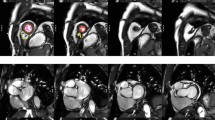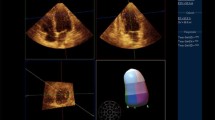Abstract
To assess reference values for left ventricular (LV) and left atrial (LA) dimensions, global LV function, and LV-myocardial mass for cardiac CT. We examined 120 subjects undergoing a coronary angiography using 64-slice and dual-source CT. All individuals had a low cardiovascular risk, normal ECG, negative biomarkers, and a normal cardiac CT examination. All subjects had a negative medical history of cardiovascular disease both on admission and at clinical 6-month follow-up. The following measurements were obtained: septal wall thickness (SWT), posterior wall thickness (PWT), LV inner diameter (LVID), LA anterior posterior diameter (LADsys), end-systolic volume (ESV), and end-diastolic volume (EDV), LV-myocardial mass (LVMM). We found significant gender-related differences for all LV dimensions (SWTsys, SWTdia,PWTsys,PWTdia,LVIDsys,LVIDdia). LADsys showed no significant difference between males and females. Significant differences were found for global LV functional parameters including ESV, EDV, and SV, whereas no significant differences were found for the EF. LV-myocardial mass parameters showed significant gender-related differences. No significant correlation was found between any of these parameters and age. All data were transferred to percentile ranks. This study provides gender-related reference values and percentiles for LV and LA quantitative measurements for cardiac CT and should assist in interpreting results.




Similar content being viewed by others
References
Shah PK, Maddahi J, Staniloff HM et al (1986) Variable spectrum and prognostic implications of left and right ventricular ejection fractions in patients with and without clinical heart failure after acute myocardial infarction. Am J Cardiol 58:387–393
Schocken DD, Arrieta MI, Leaverton PE, Ross EA (1992) Prevalence and mortality rate of congestive heart failure in the United States. J Am Coll Cardiol 20:301–306
Leschka S, Alkadhi H, Plass A et al (2005) Accuracy of MSCT coronary angiography with 64-slice technology: first experience. Eur Heart J 26:1482–1487
Raff GL, Gallagher MJ, O’Neill WW, Goldstein JA (2005) Diagnostic accuracy of noninvasive coronary angiography using 64-slice spiral computed tomography. J Am Coll Cardiol 46:552–557
Scheffel H, Alkadhi H, Plass A et al (2006) Accuracy of dual-source CT coronary angiography: First experience in a high pre-test probability population without heart rate control. Eur Radiol 16:2739–2747
Nikolaou K, Knez A, Rist C et al (2006) Accuracy of 64-MDCT in the diagnosis of ischemic heart disease. AJR Am J Roentgenol 187:111–117
Mollet NR, Cademartiri F, van Mieghem CA et al (2005) High-resolution spiral computed tomography coronary angiography in patients referred for diagnostic conventional coronary angiography. Circulation 112:2318–2323
Fox K, Garcia MA, Ardissino D et al (2006) Guidelines on the management of stable angina pectoris: executive summary: the Task Force on the Management of Stable Angina Pectoris of the European Society of Cardiology. Eur Heart J 27:1341–1381
Budoff MJ, Achenbach S, Blumenthal RS et al (2006) Assessment of coronary artery disease by cardiac computed tomography: a scientific statement from the American Heart Association Committee on Cardiovascular Imaging and Intervention, Council on Cardiovascular Radiology and Intervention, and Committee on Cardiac Imaging, Council on Clinical Cardiology. Circulation 114:1761–1791
Dewey M, Muller M, Teige F et al (2006) Multisegment and halfscan reconstruction of 16-slice computed tomography for assessment of regional and global left ventricular myocardial function. Invest Radiol 41:400–409
Juergens KU, Grude M, Maintz D et al (2004) Multi-detector row CT of left ventricular function with dedicated analysis software versus MR imaging: initial experience. Radiology 230:403–410
Yamamuro M, Tadamura E, Kubo S et al (2005) Cardiac functional analysis with multi-detector row CT and segmental reconstruction algorithm: comparison with echocardiography, SPECT, and MR imaging. Radiology 234:381–390
Busch S, Johnson TR, Wintersperger BJ et al (2007) Quantitative assessment of left ventricular function with dual-source CT in comparison to cardiac magnetic resonance imaging: initial findings. Eur Radiol, E-published Oct 7, DOI 10.1007/s00330–007–0767-y
Schwartzman D, Lacomis J, Wigginton WG (2003) Characterization of left atrium and distal pulmonary vein morphology using multidimensional computed tomography. J Am Coll Cardiol 41:1349–1357
Ilercil A, O’Grady MJ, Roman MJ et al (2001) Reference values for echocardiographic measurements in urban and rural populations of differing ethnicity: the Strong Heart Study. J Am Soc Echocardiogr 14:601–611
Devereux RB, Roman MJ, de Simone G et al (1997) Relations of left ventricular mass to demographic and hemodynamic variables in American Indians: the Strong Heart Study. Circulation 96:1416–1423
Lang RM, Bierig M, Devereux RB et al (2006) Recommendations for chamber quantification. Eur J Echocardiogr 7:79–108
Alfakih K, Plein S, Thiele H et al (2003) Normal human left and right ventricular dimensions for MRI as assessed by turbo gradient echo and steady-state free precession imaging sequences. J Magn Reson Imaging 17:323–329
Clay S, Alfakih K, Radjenovic A et al (2006) Normal range of human left ventricular volumes and mass using steady state free precession MRI in the radial long axis orientation. Magma 19:41–45
Nikitin NP, Loh PH, de Silva R et al (2006) Left ventricular morphology, global and longitudinal function in normal older individuals: a cardiac magnetic resonance study. Int J Cardiol 108:76–83
Sandstede J, Lipke C, Beer M et al (2000) Age- and gender-specific differences in left and right ventricular cardiac function and mass determined by cine magnetic resonance imaging. Eur Radiol 10:438–442
Juergens KU, Fischbach R (2006) Left ventricular function studied with MDCT. Eur Radiol 16:342–357
Wilson PW, D’Agostino RB, Levy D et al (1998) Prediction of coronary heart disease using risk factor categories. Circulation 97:1837–1847
Hoff JA, Chomka EV, Krainik AJ et al (2001) Age and gender distributions of coronary artery calcium detected by electron beam tomography in 35,246 adults. Am J Cardiol 87:1335–1339
Leschka S, Scheffel H, Desbiolles L et al (2007) Image quality and reconstruction intervals of dual-source CT coronary angiography: recommendations for ECG-pulsing windowing. Invest Radiol 42:543–549
Flohr TG, McCollough CH, Bruder H et al (2006) First performance evaluation of a dual-source CT (DSCT) system. Eur Radiol 16:256–268
Hausleiter J, Meyer T, Hadamitzky M et al (2006) Radiation dose estimates from cardiac multislice computed tomography in daily practice: impact of different scanning protocols on effective dose estimates. Circulation 113:1305–1310
Stolzmann P, Scheffel H, Schertler T et al (2007) Radiation dose estimates in dual-source computed tomography coronary angiography. Eur Radiol 2007 Oct 2; [Epub ahead of print] DOI 10.1007/s00330–007–0786–8
Du Bois D, Du Bois EF (1989) A formula to estimate the approximate surface area if height and weight be known. 1916. Nutrition 5:303–311
St John Sutton M, Pfeffer MA, Moye L et al (1997) Cardiovascular death and left ventricular remodeling two years after myocardial infarction: baseline predictors and impact of long-term use of captopril: information from the Survival and Ventricular Enlargement (SAVE) trial. Circulation 96:3294–3299
Milani RV, Lavie CJ, Mehra MR et al (2006) Left ventricular geometry and survival in patients with normal left ventricular ejection fraction. Am J Cardiol 97:959–963
Tsang TS, Barnes ME, Gersh BJ, Bailey KR, Seward JB (2002) Left atrial volume as a morphophysiologic expression of left ventricular diastolic dysfunction and relation to cardiovascular risk burden. Am J Cardiol 90:1284–1289
Kizer JR, Bella JN, Palmieri V et al (2006) Left atrial diameter as an independent predictor of first clinical cardiovascular events in middle-aged and elderly adults: the Strong Heart Study (SHS). Am Heart J 151:412–418
Bonow RO, Carabello BA, Kanu C et al (2006) ACC/AHA 2006 guidelines for the management of patients with valvular heart disease: a report of the American College of Cardiology/American Heart Association Task Force on Practice Guidelines (writing committee to revise the 1998 Guidelines for the Management of Patients With Valvular Heart Disease): developed in collaboration with the Society of Cardiovascular Anesthesiologists: endorsed by the Society for Cardiovascular Angiography and Interventions and the Society of Thoracic Surgeons. Circulation 114:e84–e231
Rodkey SM, Ratliff NB, Young JB (1998) Textbook of Cardiovascular Medicine. Lippincott-Raven, Philadelphia, PA
White HD, Norris RM, Brown MA et al (1987) Left ventricular end-systolic volume as the major determinant of survival after recovery from myocardial infarction. Circulation 76:44–51
Salm LP, Schuijf JD, de Roos A et al (2006) Global and regional left ventricular function assessment with 16-detector row CT: comparison with echocardiography and cardiovascular magnetic resonance. Eur J Echocardiogr 7:308–314
Mahnken AH, Bruder H, Suess C et al (2007) Dual-source computed tomography for assessing cardiac function: a phantom study. Invest Radiol 42:491–498
Verdecchia P, Schillaci G, Borgioni C et al (1998) Prognostic significance of serial changes in left ventricular mass in essential hypertension. Circulation 97:48–54
Raman SV, Shah M, McCarthy B, Garcia A, Ferketich AK (2006) Multi-detector row cardiac computed tomography accurately quantifies right and left ventricular size and function compared with cardiac magnetic resonance. Am Heart J 151:736–744
Gardin JM, Savage DD, Ware JH, Henry WL (1987) Effect of age, sex, and body surface area on echocardiographic left ventricular wall mass in normal subjects. Hypertension 9:II36–II39
Dannenberg AL, Levy D, Garrison RJ (1989) Impact of age on echocardiographic left ventricular mass in a healthy population (the Framingham Study). Am J Cardiol 64:1066–1068
Sievers B, Kirchberg S, Bakan A, Franken U, Trappe HJ (2004) Impact of papillary muscles in ventricular volume and ejection fraction assessment by cardiovascular magnetic resonance. J Cardiovasc Magn Reson 6:9–16
Acknowledgements
This research was supported by the National Center of Competence in Research, Computer-Aided and Image-Guided Medical Interventions of the Swiss National Science Foundation.
Author information
Authors and Affiliations
Corresponding author
Rights and permissions
About this article
Cite this article
Stolzmann, P., Scheffel, H., Leschka, S. et al. Reference values for quantitative left ventricular and left atrial measurements in cardiac computed tomography. Eur Radiol 18, 1625–1634 (2008). https://doi.org/10.1007/s00330-008-0939-4
Received:
Revised:
Accepted:
Published:
Issue Date:
DOI: https://doi.org/10.1007/s00330-008-0939-4




